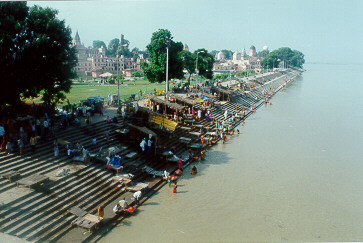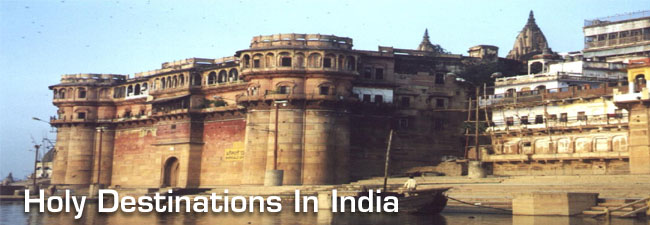 Ayodhya
Ayodhya
Ayodhya, a very holy city and is an important pilgrimage site.
Lord Rama was born and had many of His pastimes here. It is
said to have once had a perimeter of 96 miles and was the capital
of Koshala. It is on the banks of the Gogra (Ghaghara or Saryu)
River, bathing in which is supposed to destroy even the sin
of killing a Brahmin. On the right bank of the river Ghagra
or Saryu, as it is called within sacred precincts, stands the
holy city of Ayodhya, believed to be the birth place of lord
Rama, the seventh incarnation of lord Vishnu. Ayodhya during
ancient times was known as Kosaldesa. The Atharvaveda describes
it as "a city built by gods and being as prosperous as
paradise itself". The illustrious Ikshvaku of the solar
clan (suryavamsa) was the ruling dynasty of this region. Ayodhya
is pre-eminently a city of temples yet, all the places of worship
here, are not only of Hindu religion. At Ayodhya several religions
have grown and prospered simultaneously and also at different
periods of time in the past. Remnants of Hinduism, Buddhism,
Jainism and Islam can still be found in Ayodhya. According to
Jain belief, five tirthankaras were born at Ayodhya, including
Adinath (Rishabhadeva), the 1st tirthankar.
Location and Access
Area : 10.24 Sq. km.
Population : 40642 (1991 census)
Season : October - March.
How to Get There
Air : For Ayodhya the nearest airports are
Amausi, Bumrauli and Babatpur.
Rail : Ayodhya is situated on the broad gauge
northern railway line on Mughal Sarai- Lucknow main route. Ayodhya/Faizabad
are connected to various parts of the country by rail lines.
Road : Connected by road to several major
cities and towns.
To Top Prime Pilgrimage Attractions
Guptar Ghat - The Amarnath Yatra is organised
every year by the J &K Govt. during the month of Shravan
(July and August); the dates however, vary every year looking
at the weather conditions and according to Purnima (Raksha Bandhan)
in the month of Sharavan (Vikrama Samwat). This year Yatra will
be taken up from 08 July 2003 to 08 August 2003.
Ramkot -The chief place of worship in Ayodhya
is the site of the ancient citadel of Ramkot, which stands on
an elevated ground in the western part of the city. Although
visited by pilgrims through out the year, this sacred place
attracts devotees from all over India and abroad, on 'Ramnavami',
the day of the lord's birth, which is celebrated with great
pomp and show, in the Hindu month of Chaitra (March-April).
The Hanuman Garhi - Situated in the centre
of the town, this temple is approachable by a flight of 76 steps.
Legend has it that Hanuman lived here, in a cave and guarded
the Janmabhoomi or Ramkot. The main temple contains the statue
of Anjani, with child Hanuman, seated on her lap. The devotees
believe that all their wishes will be granted with a visit to
this holy shrine. A massive structure in the shape of a four-sided
fort with circular bastions at each corner, houses a temple
of Hanuman and is the most popular shrine in Ayodhya.
Treta-Ke-Thakur - This temple stands at the
place, where Rama is said to have performed the Ashvamedha Yagya.
About 300 years ago, the Raja of Kullu built a new temple here,
which was improved by Ahilyabai Holkar of Indore, during 1784.
At the same time, the adjoining ghats were also built. The initial
idols in black sandstone were recovered from Saryu and placed
in the new temple, famous as Kaleram-ka-Mandir.
Nageshwarnath Temple - The temple of Nageshwarnath,
is said to have been established by Kush, the son of Rama. Legend
has it that Kush lost his armlet, while bathing in the river
Saryu, which was picked up by a nag-kanya, who fell in love
with him. As she was a devotee of Shiva, Kush erected this temple
for her. It is said that this is the only temple to have survived
till the time of Vikramaditya, the rest of city had fallen into
ruins and was covered by dense forests. It was by means of this
temple that Vikramaditya was able to locate Ayodhya and the
sites of different shrines here. The festival of Shivratri is
celebrated here with great pomp & show.
To Top Other Pilgrimage Attractions
There is a nice area by the river surrounding Lakshman Ghat.
Lakshman, the brother of Rama, is said to have bathed at Lakshman
Ghat.Vasistha Kund is a temple with a small round kund like
a well. Rama is said to have performed a yajna (sacrifice) at
Treta Ka Mandir. There are Sita-Rama Deities in this temple.
Kaushalya, the mother of Rama, is said to have established the
Kshireswara Nath Temple for Sita. Bharata Kund, at Nandigram,
20 km from Ayodhya, is said to be the place where Bharata ruled
while Rama was in exile for 14 years. A half km north of Janmabhoomi
is Swarga Dwara, or Ram Ghat, which is an important bathing
ghat.
Festivals
Shravan Jhoola Mela (July-August) Parikrama Mela (October-November)
Ram Navmi (March-April) Rathyatra (June-July) Saryu Snan (October-November)
Ram Vivah (November) Ramayan Mela.take place at any time or
place during the Yatra . It is to be particularly noted that
abrupt changes in temperature might occur. Sunny weather may
turn into rain / snowfall in a short time. The temperature may
fall up to -5 degree C.
